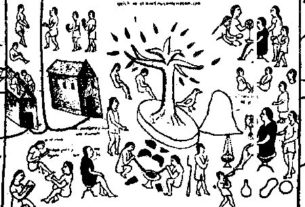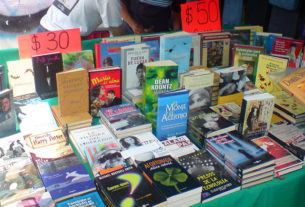This title has nothing to do with the state of affairs that precedes matrimony. It is intended in the sense of what the French call an homme engagé, literally, a man engaged in a cause or in some important work. From Winston Churchill to Leon Trotsky, from Andrd Malraux to Charles de Gaulle, the writer in politics is the ultimate homme engagé. Some — notably Trotsky — wrote history as they made it. Others wrote reflective memoirs long after the events they recorded were — as today’s saying goes — history. Still others wrote on subjects that had nothing to do with their public lives.
A notable representative of the latter tradition was Agustin Yañez. Yañez was born in Guadalajara on May 4, 1904. In the course of his seventy-six years, he distinguished himself as an educator, statesman, politician and journalist. From the tender age of fifteen, he held posts in a number of educational institutions in Guadalajara, eventually becoming a professor at the National University. He represented Mexico in various national and international educational meetings, in addition to serving as ambassador to Argentina and to UNESCO. In the arena of domestic politics, he was governor of Jalisco from 1953-59, an adviser to President Adolfo López Mateos and secretary of education in the cabinet of President Gustavo Díaz Ordaz. He was also editor of three journals: Bandera de Provincias in Guadalajara (1929-30), Occidente in Mexico City (1944-45) and Filosfia y Letras (1946-47)and on the editorial boards of several other publications. He died in Mexico City on January 17, 1980.
Considering Yañez’s own career as a political man, one is astounded by the scarcity of political themes in his works. He was, par excellence, a regional and cultural writer. Since his family derived from the Los Altos area of northeastern Jalisco, he was blessed with an abundance of material.
Los Altos is one of the most unusual enclaves in Mexico. With a largely European-descended population, many with fair hair and blue eyes, it is a patria chica (“little fatherland”) known for cattle raising, dairy farming, charros (Mexican rodeo riders), tequila cultivation, extravagant machismo, and handsome, haughty women. Fervently Catholic, Los Altos was a focal point of the 1926-29 Cristero Rebellion against an anticlerical federal government. Curiously, there is little mention of the Cristeros in any of Yañez’s books. One suspects that his status as a state and federal official inhibited him from writing about so controversial a topic.
Yañez is best known for two novels, Al filo del agua (“The Edge of the Storm”), published in 1947, and Las tierras flacas (“The Lean Lands”), which first came out in 1963. Both were translated into English, the former in 1963 and the latter in 1968. Since Las tierras flacas deals with the author’s native Los Altos, while Al filo del agua is centered in the Bajío, a rich agricultural basin between Guadalajara and Mexico City, I consider the former to be Yañez’s true roman à clef. It is therefore deserving of further comment.
The action takes place during the 1920s in the rural village of Clamores, a fictional name for the Los Altos community of Yahualica. The central figure is an old fashioned cacique (roughly, local chief) named Epifanio Trujillo. Epifanio rules this isolated region as absolutely as any divine right monarch. His power is based on the total isolation of Clamores. Though the Revolution has come and gone, townspeople still believe that Porfirio Díaz is the president of Mexico and an airplane flying overhead is considered a manifestation of the Devil.
With so many women at his beck and call, Epifanio feels no need to ever marry. The ultimate swinging bachelor, he fathers 104 children. Over these he exercises a complete right of patria potestad. Promising sons become landowners and promising daughters marry well; others are reduced to lifelong servitude as laborers, sharecroppers and domestic servants.
This stifling environment serves to magnify whatever potential the children may have for good or evil. One son becomes a liberal reformer determined to modernize Clamores, a daughter becomes a fanatical puritan because her mother left Epifanio to become a prostitute, and another son develops into a Iago-like monster of evil. The latter hires thugs to blind a beloved old faith healer so he can blame his prudish half-sister (who had quarreled with the old woman) and claim a major share of his father’s estate.
For his realism and minutely accurate warts-and-all portrayals, Yañez has been compared to Balzac. Yet in several episodes of Las tierras flacas he ratchets grimness up to the level of such classics of morbidity as Titus Andronicus.
Though Yañez is not as well known to the general readership in the U.S. as such writers as Carlos Fuentes and Octavio Paz, he has attracted impressive attention in the academic community. Among books and articles that deal with Yañez’s writing are Mexico in Its Novel by John S. Brushwood, “Social and Stylistic Realities in the Fiction of Agustin Yañez.” a PhD. dissertation by Barbara Graham and “Agustin Yañez: A Quantum Jump for the Mexican Novel” by Walter M. Langford, a chapter in The Mexican Novel Comes of Age .
My only regret is that Yañez chose to virtually ignore the great historical drama of his native Los Altos that was the Cristero Rebellion. Had he followed the example of such non-Mexican writers as Jean Meyer and directed his genius toward an interpretation of the cristiada, he would have been even more a subject of scholarly interest than he is today.



